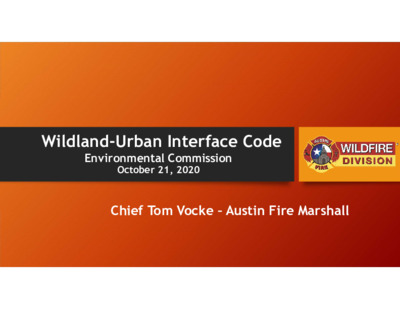20201021-003b: AFD Wildland-Urban Interface Code Update presentation — original pdf
Backup

Wildland-Urban Interface Code Environmental Commission October 21, 2020 Chief Tom Vocke – Austin Fire Marshall Key Stakeholders • Public Safety Commission, Environmental Commission, Building and Fire Code Board of Appeals • Greater Austin Home Builders Association and Real Estate Council of Austin • City, County, State departments, agencies, programs • Neighborhood organizations WUI Risk • Fire Behavior and Built Environment • Fire spread and intensity • Topography • Structure Density Risk Statistics Zones are proximity to Wildlands 1 – within 150 feet 2 – within 400 feet 3 – within 1,000 feet 4 – within 1.5 miles (Ember Zone) 5 – beyond 1.5 miles Three potential types of ignition sources: Ember Attacks (aka Firebrands) • Most home losses in a wildfire are from embers, not by direct contact with flames. Surface Fires ground litter. • Typically small flames burning through grass and • Can reach houses if there’s no interruption in • Use of Shaded Fuel Break to help reduce the risk. • Flames touching a house can cause them to fuel. ignite. Crown Fire • Large flames burning in the tops or canopies of trees. • Radiate heat that can ignite wood walls from up to 100’ away. Firewise USA® • More than 1,500 recognized • Residents reducing wildfire risks • Taking action and ownership • • Preparing Protecting their homes • There are over 100 in Texas • 18 in Austin • Austin Firewise Alliance • Communities coming together to educate and promote FAC • Many more are engaged with AFD Austin Fire Department Effective Fire Fighting • Quick initial response • Continuous training • Proper equipment Wildland-Urban Interface (WUI) Code • Council adopted April 9, 2020 • Implementation January 1, 2021 • Administrative rules in development now WUI Code • Technical Building Code • 2015 ICC Model Code - IWUIC • Ignition resistant construction • Defensible space allowed to mitigate distinct hazard WUI Code Areas • Developable properties near wildlands • 150’ from 40 acre • 1.5 miles from 750 acre • Ignition resistant roofs and vent screening throughout • Ignition resistant walls, doors, windows if within 50’ of wildland WUI Code Ignition Resistant Construction • New and remodeled structures in the WUI area • Ember protection throughout the WUI area • Class A roof, vent screens, decks and fences, underfloor enclosures • Increased requirements closest to wildlands • Ignition resistant exterior walls, doors, windows • Defensible space for hazardous conditions WUI Code Ignition Resistant Construction Materials • Fire-resistant-rated exterior walls, doors, and windows • Class A roofs with firestops if openings at eaves • Eaves and Soffits protected exposed underside • Enclosed underfloors or ignition resistant materials • Vents covered with 1/8” or less screening or mesh • Appendages and structures (decks and fences) attached to or within 10’ of structure to be fire resistant except fence materials beyond 10’ WUI Code Defensible Space • Ignition resistant construction table removed • Defensible space cannot be used to avoid ignition resistant construction • Not permitted category handled separately Moderate Hazard Water Supplyb Fire Hazard Severity High Hazard Water Supplyb Conformingd Nonconforminge Conformingd Nonconforminge Conformingd Nonconforminge Defensible Spacec Nonconforming Conforming 1.5 x Conforming R NR NR R R NR R R NR R R R NR-not required R-required NP-not permitted Extreme Hazard Water Supplyb R R R NP R R WUI Code Defensible Space • Existing use or occupancy allowed if • Legal at time of code adoption • Does not constitute distinct danger to life or property • Distinct Hazard – permit not allowed • Extreme Hazard Severity and • Non-conforming water supply, access, defensible space WUI Code Defensible Space Hazard Severity M - Moderate H - High E - Extreme Appendix C - Hazard Severity Form WUI Code Defensible Space Area of modified fuel to slow the rate and intensity of a wildfire and to create space for fire suppression operations Distances based on Hazard Severity Moderate 30 feet High 60 feet Extreme 100 feet WUI Code Defensible Space • 30 feet or to property line or more based on site conditions • Ground cover and tree canopy • Break continuity • Reduce structure ignition potential • 6’ wide by 8’ high clear zone within 15’ of structure • Maintain seperations and clearances WUI Code Defensible Space • Tree canopy seperation from ground cover and structures • 6 feet or less if demonstrated low risk of fire transfer • Ground cover includes any understory vegetation • Plan for future growth and maintain separation • Plan can be prepared by a qualified professional WUI Code Defensible Space • Not all fire transfer materials and methods regulated by this code – leaf litter, debris, lattices, door mats, open doors or windows • Determine risk and follow recommendations • On-line: ATX wildfire, WUI Code, Firewise USA® , Ready Set Go ®, Austin Travis County Community Wildfire Protection Plan • Home Ignition Zone Assessment from AFD or Firewise USA ® member, or other qualified professional such as wildfire qualified arborist WUI Code Recap • Focus on ignition resistant construction • WUI Area includes ember zone • Defensible space not allowed to avoid ignition resistant construction • Know risk and follow recommendations • Assistance available: AFD, Firewise USA ® members, Certified Arborist with Texas Wildfire Risk Reduction Qualification WUI Code AFD Wildfire Division – Station 46 Shady Hollow Intact structure after exposure to fire in California